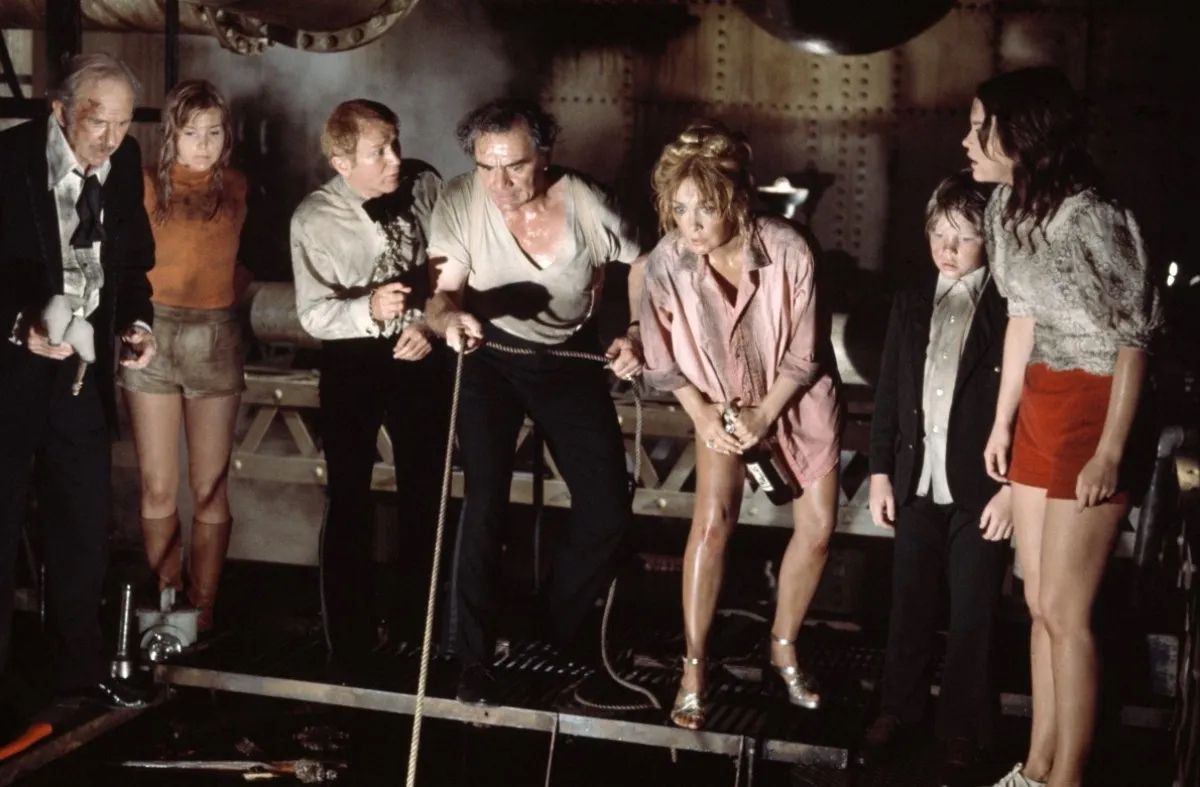 Originally published 5/18/22 on Substack.
Originally published 5/18/22 on Substack.
Hey folks! The following post isn’t about movies, and is entirely about role-playing games. Worse, it’s theory about role-playing games, from a guy who probably should know better. I try to write about both movies and rpgs with an eye towards accessibility for those with no inherent interest in either topic (with varying degrees of success). However, if you, as a cinephile, find this entry to be one toke over the line, I understand! Look for a regular post, on 11 Harrowhouse (1974, Aram Avakian), next week.
 I did an image search for “Adventuring Against the ’70s” and this Poseidon Adventure photo came up. Works for me!
I did an image search for “Adventuring Against the ’70s” and this Poseidon Adventure photo came up. Works for me!
The whole point of the Against the 70s newsletter/Patreon1 is to work through ideas for a 1970s rpg setting, probably for, but not necessarily exclusive to, the Cypher System rpg. This setting should encompass a lot of the famous motifs of the decade (ecological dystopia, blaxploitation, disco, paranoia, The “Me” Decade) as well as some weird outlier concepts that are meaningful to me (like Laserblast and Phantasm). But a setting doesn’t exist just for itself. A setting only exists as a context for player and GM interaction. That interaction usually takes the form of an “adventure,” whether published, prewritten in some form by the GM, or completely improvised by the GM. This leads to a major question: what do adventures look like for an Against the 70s game?
It might seem a bit cart before the horse to think about adventures before I have the thing itself written. But I disagree. An rpg reveals a lot about itself by the kind of adventures it expects GMs to run for players, and especially by the kind of adventures written and published for it.
I have an answer to my question, or at least the outline of one, in mind, but I want to go through my thinking step by step. Things are about to get small and pedantic, so you’ve been forewarned.
Now, nearly every rpg has, at its heart, the same conceptual DNA2. One person acts as a narrator, describing the imaginary world for the other players. Each of the players controls a character in this world. The narrator asks the players what their characters do, and the players respond. The narrator then describes what has happened based on the characters’ actions3. An rpg, then, is a conversation. It is almost entirely inevitable for these conversations to coalesce into narrative units of “scenes” or “encounters.” A sword & sorcery rpg session, for example, could recapped as three scenes: “We met some Halfings in distress because of a dragon in their village” (scene #1) “and we went through the haunted forest to get to the village but we were attacked by giant spiders” (scene #2) “but after that we arrived at the Halfing village, where there was no dragon, but we met a wizard who told us the dragon flew off to its lair in the mountains” (scene #3). So on and so forth.
Nearly every written rpg adventure leans into conversation-as-scenes. It’s just too obvious and easy for them not to. However, the way that a written adventure does this varies widely. Written adventures are, by definition, weird, as they are created for a kind of game that offers unprecedented freedom - if it makes sense in the fiction of the game (and sometimes, even if it doesn’t), a player can have their character attempt anything. A written adventure, by its very nature, constrains that freedom. That’s good4; in rpgs and in art, constraints allow energy to be focused creatively and productively. But there is a tension there, and different kinds of written adventures handle that tension differently.
I’ve divided written adventures into a number of categories below. These categories aren’t iron-clad; written adventures often use aspects of different categories. I’d even go so far as to say these categories don’t really exist, and that I’ve only created them as a way to make talking about adventures easier. Are there more categories I could’ve come up with? Most certainly. But I think these cover my points for now.
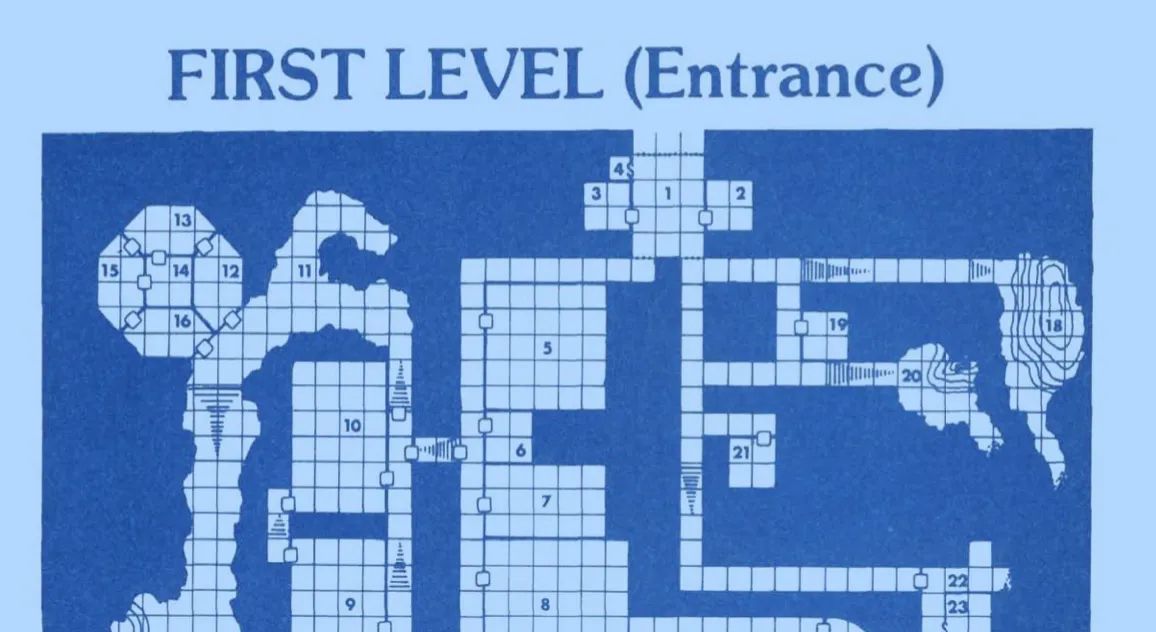 Section of a the First Level map of the Dungeons & Dragons adventure B3 Palace of the Silver Princess.
Section of a the First Level map of the Dungeons & Dragons adventure B3 Palace of the Silver Princess.
Classic D&D-style adventure. In this kind of adventure, the characters explore a location, usually large, and usually literally rooms connected by corridors. Each room is usually a “scene,” in that there is a self-contained encounter within: the Orc raiders trashing a kitchen while looking for food, the mysterious fountain that holds a magical secret, the dragon in its lair. The physical space usually has a some kind of narrative “container” to place it in some sort of context: the characters are going into the dragon’s cave to rescue the prince, the characters are going into the tomb to retrieve the magic amulet that will revive the queen, the characters are going into the seemingly-abandoned fortress to score some choice loot. Regardless of the container, though, the adventure is defined, at least experientially, by a series of room encounters.
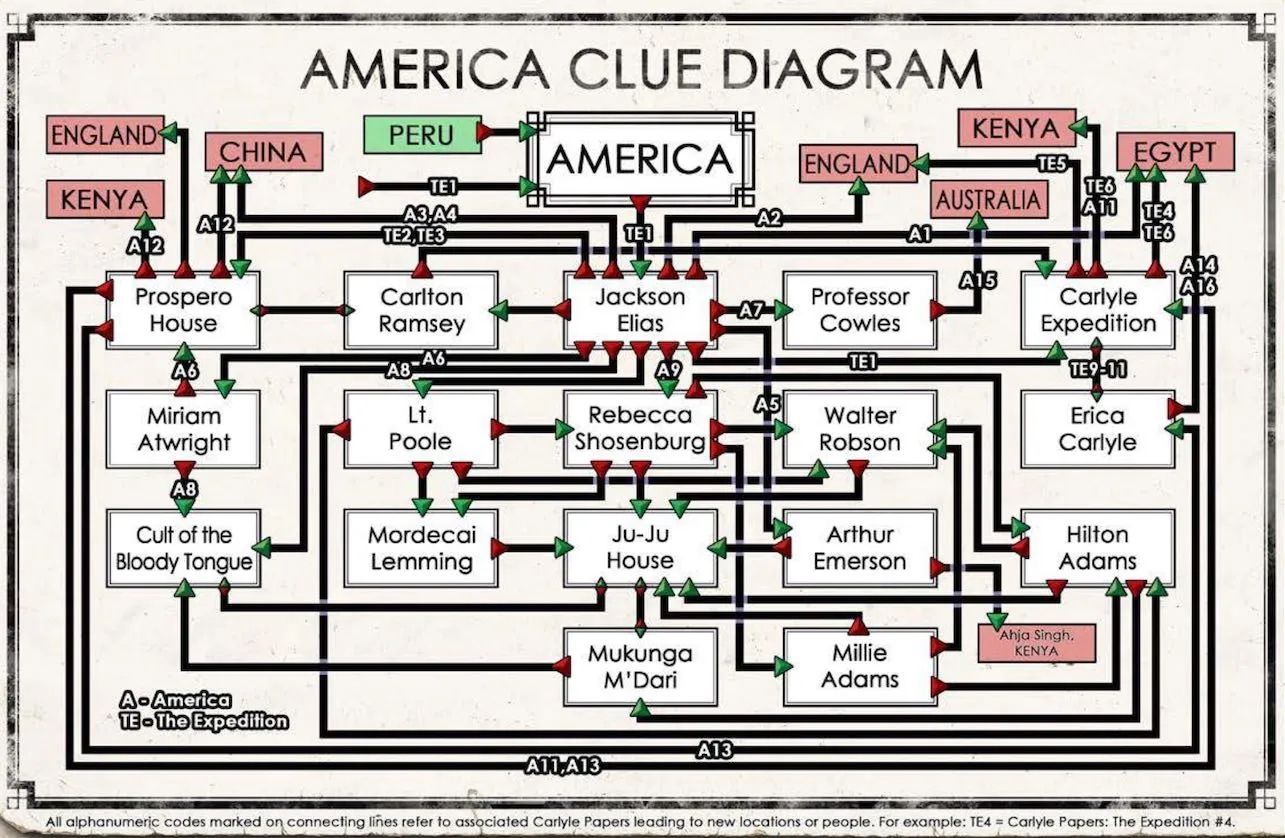 “America Clue Diagram” from the New York section of Masks of Nyarlathotep Omnibus PDF by Larry DiTillio & Lynn Willis. Most investigative adventures are less convoluted than this; Masks is considered one of the densest adventures ever written.
“America Clue Diagram” from the New York section of Masks of Nyarlathotep Omnibus PDF by Larry DiTillio & Lynn Willis. Most investigative adventures are less convoluted than this; Masks is considered one of the densest adventures ever written.
Investigative adventure. This is the kind of adventure you find in a game like Call of Cthulhu, where there is usually some of kind of mystery to be solved. The locations are often spread out across a large area, and the characters explore each location, talking to the NPCs there, finding clues, until they can unravel the mystery. Here’s the secret behind an investigative adventure, though: structurally, it’s no different than the classic D&D-style adventure. Both kinds of adventures can be simplified/abstracted into a diagram, with shapes for rooms or locations or encounters, and lines for corridors or roads or what have you. The primary difference, then, is how each one is represented in the fiction of the game, which has real consequences. In a classic D&D dungeon, if things go pear-shaped in a room, the characters can retreat to another room… which could be empty, or could have more monsters in it. In an investigative adventure, locations usually have significant distance between them, so if things go bad for the characters, they are usually stuck in that “room.”5
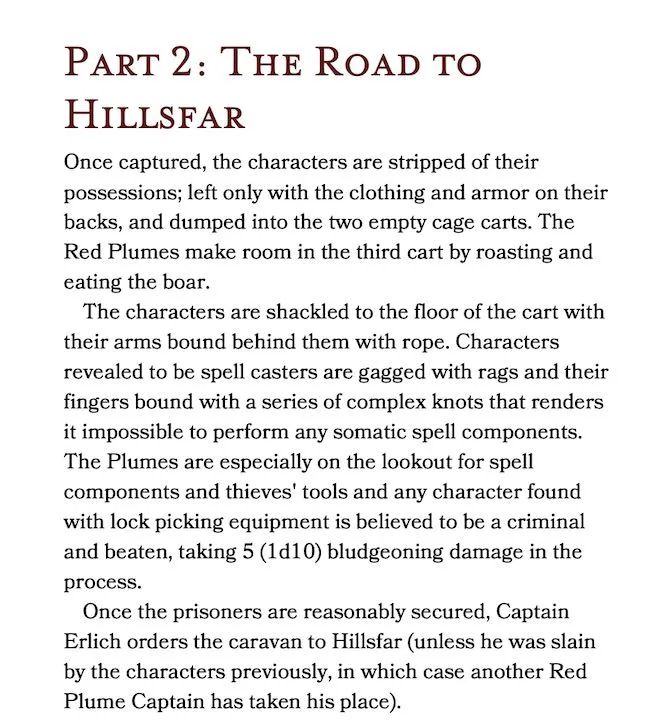 From Shackles of Blood by Joshua Kelly, an “Adventurers League” scenario for Dungeons & Dragons. The opening phrase “Once captured” should give anyone pause, as there are a load of assumptions there. However, this is an adventure intended to played at a game store within a fixed amount of time, and most players will understand that their characters need to be captured to move the story along.
From Shackles of Blood by Joshua Kelly, an “Adventurers League” scenario for Dungeons & Dragons. The opening phrase “Once captured” should give anyone pause, as there are a load of assumptions there. However, this is an adventure intended to played at a game store within a fixed amount of time, and most players will understand that their characters need to be captured to move the story along.
Scene-by-scene adventure. There are some adventures that are structured in a scene-by-scene way - the encounters come to the characters in a linear way, almost like a treadmill. With each encounter, the characters are faced with a problem or situation or combat, and they interact with it until the scene is resolved in some way. Then they move on to the next scene. Although the characters are free to make choices inside of a scene, they generally have little choice as to the next scene. This kind of adventure curtails the kind of natural freedom that is unique to rpgs, and as such, is generally frowned-upon and considered “railroading.”6 I don’t think there’s anything inherently bad about the concept; it’s just another tool to use. The advantage of this kind of written adventure is that, because of its treadmill-like nature, it can be completed in a shorter amount of time - perfect for conventions or at a game store, where time can be limited.
 Based on the image search, apparently The Situation does this shirt thing a lot? Anyway, it feels like a metaphor for when I start talking about theory and philosophy, and not in a good way.
Based on the image search, apparently The Situation does this shirt thing a lot? Anyway, it feels like a metaphor for when I start talking about theory and philosophy, and not in a good way.
The Situation. This is a more recent idea on how to present adventures, almost more of an overlay than an actual category. The idea is to take something location based, like the classic D&D adventure, and then take a holistic approach to it. Instead of treating each room as a discrete encounter, the GM takes the location and its inhabitants as a whole, and reacts to the players’ actions in a way that makes sense. The dungeon may have 20 Kobold guards within it, but the GM decides where these guards might be, depending on time of day, what kind of schedule they would keep, and what kind of actions (like making noise) the characters make. In other words, in a classic D&D adventure, the rooms are like dioramas frozen in time, or like rooms in a real-life haunted house attraction, just waiting for characters to enter and “start.” In a situation, the room contents are flexible. This provides a more “realistic” experience, but also is more difficult for a GM, as it requires more of their creativity and judgement.7
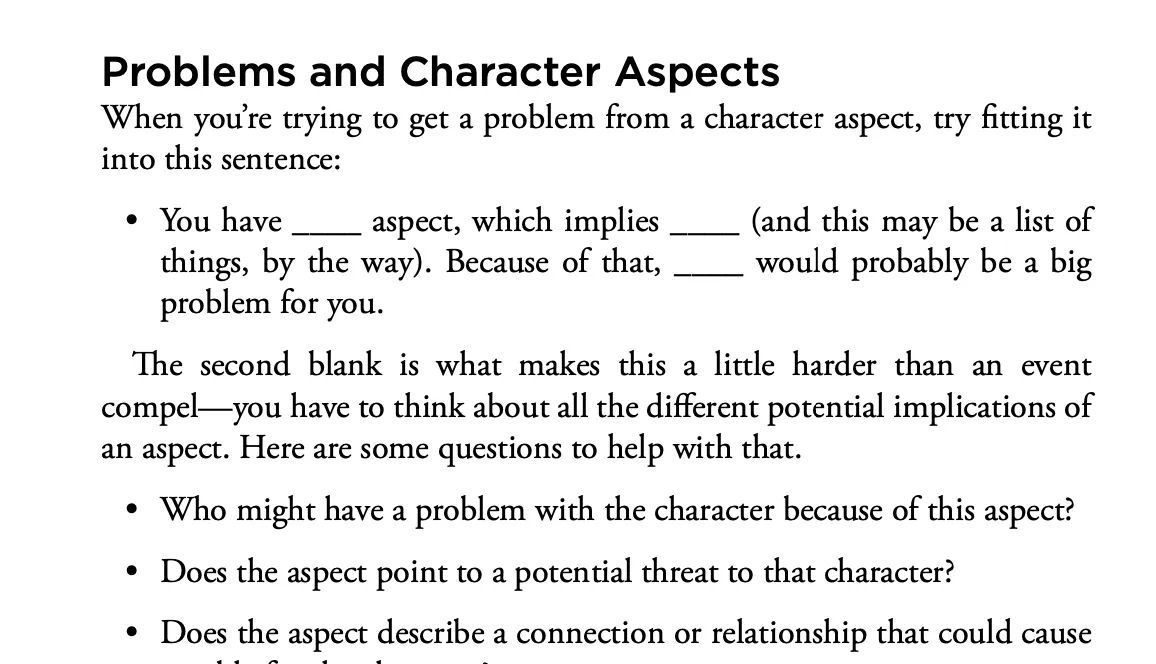 Part of the method to generate “problems” in FATE, which lead to adventures. (Aspects are character descriptors that are core to the system.)
Part of the method to generate “problems” in FATE, which lead to adventures. (Aspects are character descriptors that are core to the system.)
FATE-style adventure. FATE is a system published by Evil Hat Games, and it does nearly every “normal” rpg thing in an opposite or weird way. It is fascinating. I’m not going to go into the differences in this post, but here’s how a FATE adventure, by the book, is run: you kind of just make it all up at the table? That’s not wholly accurate. There is a process, where the GM goes through a series of questions related to the characters’ backgrounds and personal problems, that helps generate a very rough outline of the adventure. Then the table - GM and the players - decide what the scene is, and what the point or goal of it is. The table then plays it out. Once the scene is done, the next scene is decided, and so on. It’s kind of like scene-by-scene, except no one, not even the GM, knows exactly what’s going to happen next. (Unlike, say, in a classic D&D adventure, where the GM knows what is beyond any given door waiting for the characters.) At the same time, it’s almost like the opposite of scene-by-scene, in that it doubles down on the freedom inherent in an rpg. The GM can prep adversaries and what those adversaries are doing, but how they will appear in the adventure is not a foregone conclusion. Because everyone at the table knows that it’s all being made up, more or less, in the moment, there’s a feeling of being pressed up against an unknowable “fog of war” if you will. And because, in this kind of adventure, nothing is really real until it happens, these kind of adventures often have “flashback” mechanisms8. These allow the table to go back in time in the fiction, to play out something that probably happened in the past. This might be necessary for the fiction “in the present” to continue, but since it didn’t happen during at play at this point, it hasn’t actually happened.
You may be wondering what a prewritten FATE adventure looks like. And then you probably intuited the answer: there aren’t any, really. I have seen some attempts at such a thing, but it’s clear that prewriting scenes or encounters is against the ethos of the system.9
There is nothing wrong with any of these adventure structures. I’ve played and GM’d all of them, and they can be great and they can be awful, which means the quality has nothing to do with the structure. My problem is that, for Against the 70s, I don’t like any of these choices, or even combination of choices. I mean, if I was forced at gunpoint to pick one or more, I could do it. But none of them feel right - some are close, but none of them, as described, quite hit the bullseye.
So, as Basehead once said, what’s the solution? I’m feeling around the edges of one, but I’m not there yet. But to even give you an idea of how I got to that preliminary point, I’ll need to talk about classic story structure. That’s a whole ’nother thing, so that’ll have to wait until part two. Stay tuned.
No link; both the original Substack newsletter and Patreon are no longer active.↩︎
Throughout this piece, I’ll be appending such qualifiers as “nearly,” “most” and “usually” to statements about rpgs. I do this because the rpg space is enormous and full of experiments writ large and small, and I haven’t read all of them. I’ve read barely a fraction of them. So, there likely are rpgs that break these “rules” I’m talking about. Nevertheless, I’m confident that what I’m saying is true for 95% of rpgs.↩︎
Usually dice are used to resolve what happens, but not always.↩︎
“…we could always use some more electrical equipment.” Shut up, brain! I’m trying to write here!↩︎
Unless, in the fiction, they have a vehicle or something and can hightail it out of there. Assuming they can get to it. Assuming it’s still there and working. Sorry, that’s the Call of Cthulhu GM in me.↩︎
“Railroading” is considered a huge sin in rpg circles, but it’s also differently defined depending on who you read. I prefer the definition that defines it as the worst-possible thing: a playstyle where the GM has determined everything in advance, so much so that the players and their characters have no agency whatsoever. If you’re unfamiliar with rpgs, that may sound ridiculous; no one would ever do that. Trust me when I say it’s a well-documented phenomenon.↩︎
11/8/24: I now realize that one major adventure type that I neglected here is something called “The Sandbox,” which, to summarize poorly, is kind of like The Situation, only writ large. I’m not going to get into here today, just know that, generally speaking, The Sandbox prioritizes player freedom above all, making it the opposite of Scene by Scene.↩︎
There’s another system of games, collected loosely under the umbrella of Powered by the Apocalypse, that, like FATE, considers adventures as something to discover and create out of nothing at the table. Some of those titles: Apocalypse World (the first that lent its name to the category), Dungeon World, Blades in the Dark, Masks: A New Generation, and Ironsworn. Ironsworn can be downloaded for free if vou’re interested in seeing what it’s like. Technically, Blades in the Dark and Ironsworn are offshoots of Powered by the Apocalypse, but if you’re new to this, there’s no reason to care.↩︎
FATE has quite a few setting books, with prewritten environments and large-scale conflicts for characters to explore and interact with, but even those seem to be, in my opinion, the antithesis of what the system is about. (In FATE, the GM and the players usually create the setting they wish to play in at the table.)↩︎
 AT70 Extra: Cypher System “Bundle of Holding” Now Available Until June 6
AT70 Extra: Cypher System “Bundle of Holding” Now Available Until June 6
 11 Harrowhouse (1974, Aram Avakian)
11 Harrowhouse (1974, Aram Avakian)